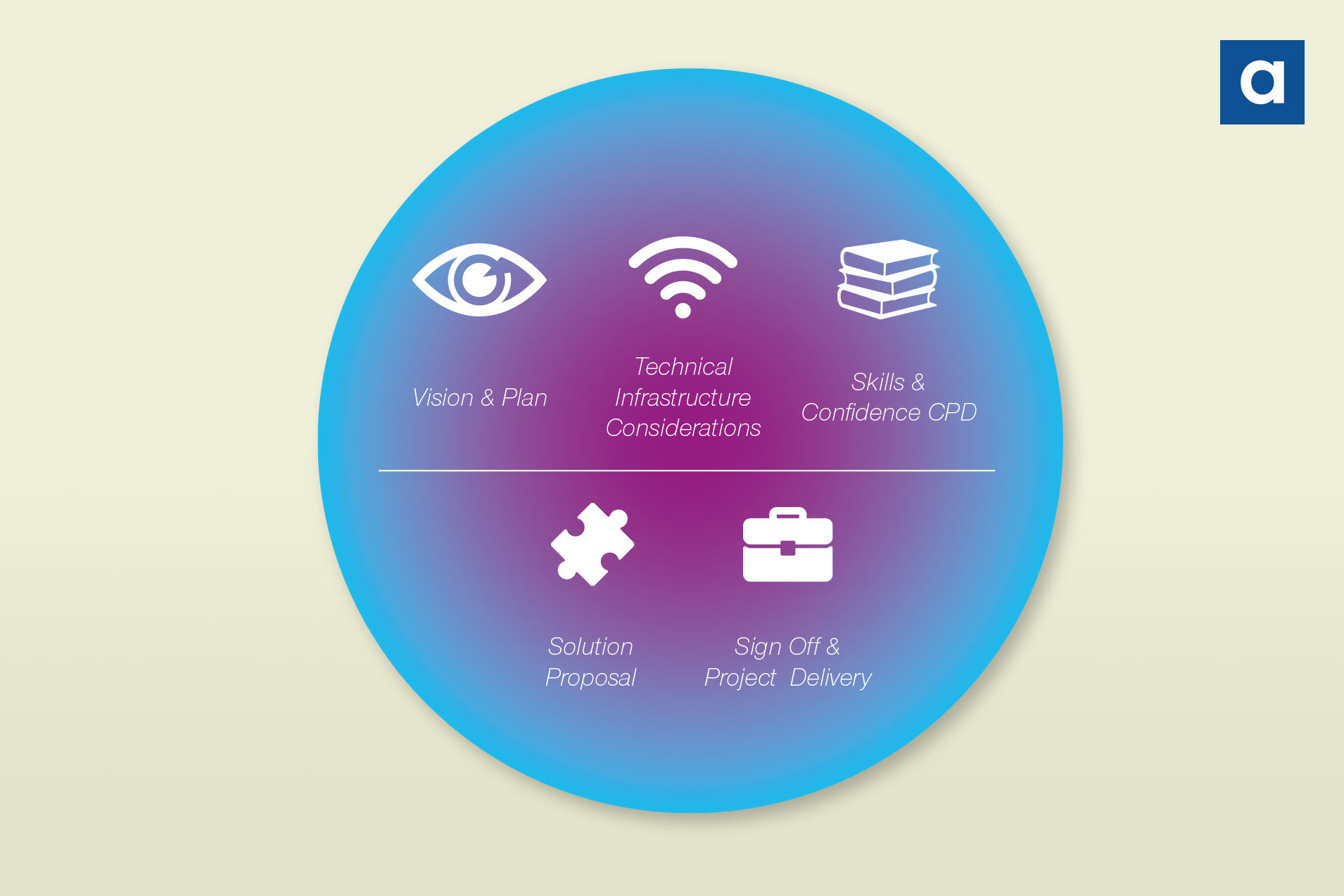
05 Feb Delivering mobile learning in the most comprehensive and cost-effective way
Academia offers a number of different options that educational establishments can consider when looking to deliver a mobile learning program. With a 5-step approach that supports the key elements that schools should consider when implementing new technologies:
- Vision and Plan
- Technical Infrastructure Considerations
- Skills & Confidence CPD
- Soluiton Proposal
- Sign Off & Project Delivery.
Regardless of the type of technology you are looking to support your teaching and learning in your education establishment, there are some key areas that will need considerations across strategic areas.
Vision & Strategic Planning
Having a strong vision and strategic plan in place with a bespoke project and deployment timeline is key to supporting success. You should consider and include the elements below:
- Desired measurements of success – impact on learning
- Ecosystem – Cloud Solution / Storage
- Network Infrastructure & Printing
- Schoolwide Workflow
- Teacher Workload / Time
- E-Safety
- Stakeholder Buy-in
- Sustainability
- Ongoing long-term CPD / Professional Development
Teaching
Do your staff have the capacity to deliver your vision as an education establishment? As an education establishment, you are going to want to make sure your staff have the best support and knowledge to deliver their teaching.
- Ongoing CPD
- Professional Development
- Digital Leaders (Teachers and Auxiliary Staff)
- Teacher Workload / Time
- Lesson Plans
- Classroom Environment
Learning
Does your vision allow you to reach the measurements of success for your expected learning outcomes? Outlining some short-term goals and in turn, the longer-term outcomes? Understanding your pre-project data “v” post-project data. The considerations of a project often don’t stop at just the technology but also the learning space. Part of the vision will often need to consider the long-term look of the classrooms and any refreshes and how the learning spaces might look down the line:
- Immediate impact “v” long term goals
- Safeguarding and E-Safety
- Learning Community
- Parent and Stakeholder Engagement
- Current learning space “v” “how do we see our learning space in 5 years” (classroom design, desks, soft seating, mobile learning)
- Digital Workspaces – anywhere, anytime learning
- Interactive White Boards “v” large LED Screens with streaming capability
- Sharing of “Best Practice” across the community.
Digital Infrastructure & Environment
An area that is most discussed but can often be forgotten and requires a core focus. Huge changes in the last 5-10 years means that the education sector is in part, hampered by “playing catch up” and the infrastructure in schools has often been built to manage (barely). Having robust WIFI that can handle the changes in workflow and storage requirements, especially if cloud computing isn’t yet part of the journey. In schools (more specifically), often a large part of the budget may need to be spent on changes in the infrastructure before the technology gets deployed allowing growth with a project staying future-proof.
- WIFI and Infrastructure Audit
- Deployment Requirements and Considerations
- Internet Bandwidth
- OTA (Over the Air) Device Management
- App Considerations
- GDPR Compliancy
- Hardware Refresh and Lifecycle Planning
- Classroom Design
Sustainability and financing should always be an important conversation. Through our longstanding experience, we are able to discuss several finance models with our customers.

Academia’s connectED programme has been designed to assist educational establishments who are considering a 1:1 device scheme. 1:1 learning allows for anytime, anywhere learning with students engaging in digital content. If this is a consideration with you, Academia can offer a direct credit portal for students and parents to purchase a device with insurance and accessories without the financial liability that comes with a traditional operating lease for an education establishment.
This parental portal offers the technology bundle chosen by the school and unlike a client operating lease, the credit facility is directly with the parent through our chosen credit facility (DEKO). The parents can choose to pay monthly or an outright purchase with the associated accessories.Insurance and warranty claims are processed via the portal. The devices are delivered to the school and therefore eligible for Education pricing.

This finance option is based on a Client Operating Lease that requires the customer to take on the financial commitment through a lease and either make the quarterly or annual payment through their own cap-ex funding or through a parent voluntary contribution scheme.
At the end of the term, Academia will work with you to either do a lifecycle refresh or the other options available to you.
A lease term is usually 2 or 3 years and insurance is required but cannot be added onto the lease.

In this finance model, Academia is responsible for the supply of the device bundles and then you, the customer, rents the technology and makes yearly upfront payments to Academia. The difference with this rental option “v” a client operating lease, is the option to have break clause at 12/24/48 months. This gives schools the option to hand the devices back at any point (please note there may be additional payments). Unlike the operating lease, because the payments are made upfront and it is a rental scheme, insurance can be added into the financing.


